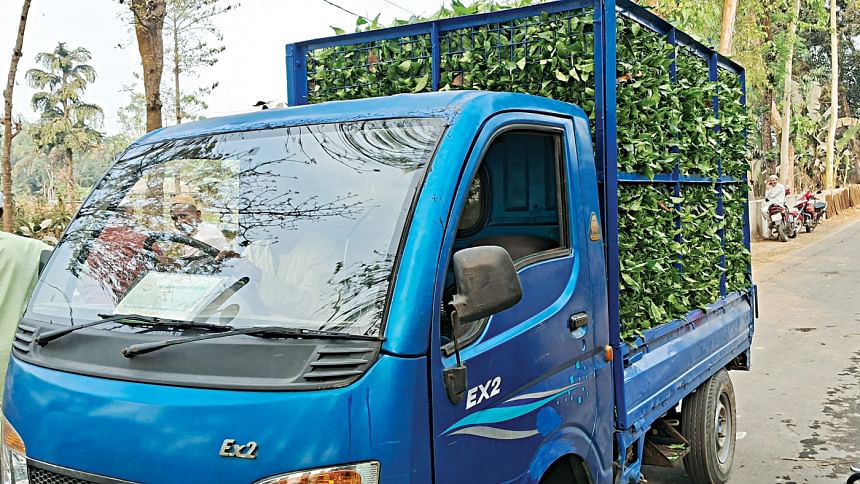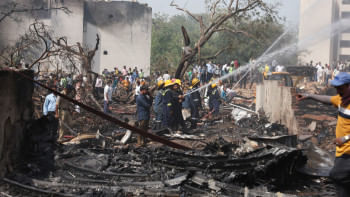Tea output in northern plains down 20% in 2024

Tea production in the northern plains dropped by nearly 20 percent in 2024, as erratic rainfall, poor market prices, and irregularities in factory accounting took a toll on the sector.
Five districts -- namely Panchagarh, Thakurgaon, Dinajpur, Nilphamari, and Lalmonirhat -- produced 14.39 million kilogrammes of processed tea last year, which accounted for 15.47 percent of the country's total output of 93 million kg, according to the Bangladesh Tea Board.
In contrast, the same region yielded 17.95 million kg in 2023, or about 17.44 percent of the national production of 102.92 million kg.
Arif Khan, a regional official of the tea board, said production had been "slightly hampered" by conditions that mirrored mid-season drought.
"At the same time, many small and marginal growers lost interest in properly caring for their plants due to a lack of fair prices," he told The Daily Star.
He lamented that some farmers, disheartened by persistently low returns, uprooted tea plants and returned to conventional crops.
Khan commented that another reason for the drop in production is that factory authorities continue to engage in short weighing -- systematically underreporting the weight of purchased tea leaves -- which conceals actual production data.
Currently, the five districts host 10 registered and 20 unregistered large tea estates alongside 2,174 registered and 6,197 unregistered small plantations.
Tea was grown on 12,132 acres in the region in 2023, but that figure shrank to 11,527 acres last year.
Yet, Panchagarh remains a key player. With nearly 9,730 acres under cultivation, the northern plains emerged as the country's third-largest tea cultivation zone after Chattogram and Sylhet last year and maintained its position as the second-highest producer for the fourth year running.

However, such prosperity may not be sustainable for much longer if small farmers, like Amraj Alam Rupom from Panchagarh's Atwary upazila, continue to turn away.
As he could not recover production costs due to the low price of raw leaves, Alam said he uprooted tea plants from one acre last year.
Samir Uddin, 45, from Nitoldoba village in Thakurgaon's Baliadangi upazila, said he was forced to sell raw leaves at just Tk 8 per kg after factory authorities cited various excuses to reduce the accepted weight of supplied leaves by 40 percent.
"The price was lower than the production cost, so I didn't make a profit last year," he said. "I will observe the market situation in the coming season. If the price trend continues, I will consider returning to cultivating traditional crops."
Some industry insiders pointed to another cause for the reported dip in output: not all tea produced in the northern districts was sold through the official auction centres in Sylhet and Chattogram, or through the new digital auction centre in Panchagarh.
ABM Akhtaruzzaman, president of the Small Tea Garden Owners Association, said a significant volume of tea from Panchagarh continues to be sold through unofficial channels.
He called for tighter monitoring of factory operations and stricter enforcement to ensure that processed tea reaches the market through proper channels.
Speaking on condition of anonymity, a factory manager admitted that some producers resort to unauthorised sales due to cash flow issues. However, he claimed such sales account for no more than 10–15 percent of total output.
Niaz Ali Chishti, general secretary of the Bought Leaf Tea Factory Owners' Association, told The Daily Star, "We have repeatedly urged factories, on behalf of our association, to refrain from selling processed tea through unofficial means."
He said that if tea continues to be sold outside the proper channels, both tea growers and well-performing factories will suffer, and the promising industry in the plains will be at risk.
Chishti urged the authorities for stronger oversight. "To completely stop this practice, the tea board, local administration, and the customs need to step up their monitoring efforts."
If necessary, stern action must be taken against offenders, he added.
Due to sales through unofficial channels, many quality companies still have unsold stock. Out of a total of 49 auctions, 46 have already taken place.
Chishti said the reason is that many buyers are sourcing tea at lower prices from outside the system, depriving revenue also for the government.
AKM Rafiqul Haque, director (project development) at the Bangladesh Tea Board, said the board had already stepped up monitoring efforts in line with instructions from its chairman.
Over the past two decades, Panchagarh's tea economy has transformed the local landscape. What was once a stretch of barren grazing land has turned into a lush, green tea belt – now the third-largest tea-producing region in Bangladesh.
Since cultivation began in 1999, the area has witnessed rapid growth. Employment has surged – from just 1,475 workers in 2006 to over 15,000 today. Roughly 30,000 people are now directly or indirectly involved in the industry.
Small-scale tea farmers earn around Tk 2–3 lakh per acre annually, making the region the country's second-highest earner in the tea sector.

 For all latest news, follow The Daily Star's Google News channel.
For all latest news, follow The Daily Star's Google News channel. 



Comments